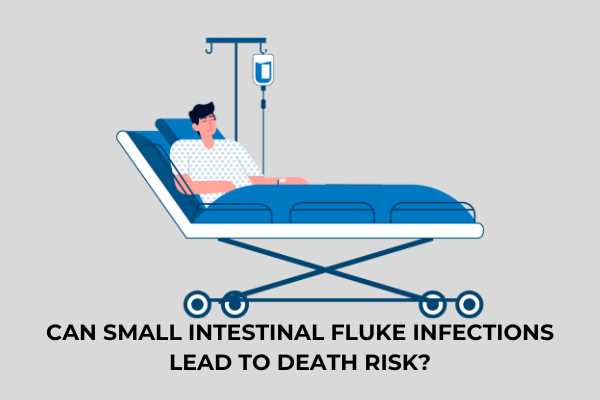Can small intestinal fluke infections with a large number of flukes lead to death risk? What are the symptoms of intestinal fluke infections that people need to know according to the guidelines of the Ministry of Health in Vietnam?
- Is small intestinal fluke infections dangerous?
- What are the causes of small intestinal fluke infections according to the guidelines of the Ministry of Health in Vietnam?
- What are the symptoms of a small intestinal fluke infection according to the guidelines of the Ministry of Health in Vietnam?
- What is the life cycle of small intestinal fluke infections according to the guidelines of the Ministry of Health in Vietnam?
Is small intestinal fluke infections dangerous?
Pursuant to Section 1 of the Guidelines issued together with Decision 1572/QD-BYT in 2022 of the Ministry of Health, there are warnings about small intestinal fluke infections as follows:
- Small intestinal fluke infections transmitted from animals to humans includes 69 species in 11 families, of which are usually caused by some species of the family Heterophyidae (31 species) and Echinostomatidae (21 species), the fluke usually parasitizes the small intestine. Infections with small numbers of flukes are usually asymptomatic; When infected in large quantities, it can cause prolonged diarrhea, nausea, abdominal cramps, fatigue, malaise, anorexia, malnutrition, anemia, and elevated peripheral white blood cells. There can be damage to the heart muscle, heart valves, or skull, bowel perforation leading to death.
Accordingly, if the patient is infected with small intestinal flukes with a large number of flukes, they may have persistent diarrhea, anorexia, malnutrition, and anemia. It can damage the heart muscle, heart valves or skull, perforation of the intestines leading to death.
Thus, with the above information, small intestinal fluke infections is very dangerous for the patient.

Can small intestinal fluke infections with a large number of flukes lead to death risk? What are the symptoms of intestinal fluke infections that people need to know according to the guidelines of the Ministry of Health in Vietnam?
What are the causes of small intestinal fluke infections according to the guidelines of the Ministry of Health in Vietnam?
Pursuant to Section 1 of the Guidelines issued together with Decision 1572/QD-BYT in 2022 of the Ministry of Health, guiding the sources of small intestinal fluke infections are as follows:
- Inoculum:
The source of the infections is a small intestinal fluke in infected humans and animals.
+ Circulation: Around the world, fascioliasis is found in Japan, China, Taiwan, Philippines, Indonesia, Korea, Thailand, Laos... In Vietnam, there are at least 18 provinces in the whole country. Country: Yen Bai, Phu Tho, Dien Bien, Lao Cai, Bac Kan, Quang Ninh, Bac Giang, Hanoi, Nam Dinh, Ninh Binh, Thanh Hoa, Hai Phong, Thai Binh, Nghe An, Thua Thien Hue, Phu Yen , Binh Dinh, Lam Dong, Dong Nai and An Giang...
+ Reservoir: The main host is humans, livestock, poultry, natural birds...
+ The intermediate host of small intestinal flukes is freshwater snail, freshwater fish, and brackish water.
- Mode of transmission
+ People infected by eating fish infected with small intestinal fluke cysts that have not been cooked.
- Infectiousness and immunity
+ Everyone can be infected with small intestinal flukes, immunity is not specific, not stable.
Accordingly, humans can be infected when eating undercooked fish infected with small intestinal fluke larvae. Small intestinal fluke is contagious to all people, regardless of sex or age.
In addition, the immunity of small intestinal fluke infections is also nonspecific and unstable.
What are the symptoms of a small intestinal fluke infection according to the guidelines of the Ministry of Health in Vietnam?
According to Section 2 of the Guidelines issued together with Decision 1572/QD-BYT in 2022 of the Ministry of Health, the clinical symptoms of small intestinal fluke infections are guided as follows:
"2. CLINICAL SYMPTOMS
2.1. Clinical symptoms
- Most cases of small intestinal fluke infections are asymptomatic.
- Severe infections may have symptoms: abdominal distension, diarrhea, intermittent abdominal pain, nausea, allergic reactions, facial edema, leg edema and possibly anemia, malnutrition.
- Infection with small intestinal flukes of the family Echinostomatidae with clinical symptoms such as abdominal pain, defecation, or fatigue are the basic symptoms manifesting more strongly than the clinical manifestations when infected with tapeworms of the family Heterophyidae due to the presence of intestinal flukes destroy the intestinal mucosa even more ulcerative in the intestinal mucosa.
2.2. Clinical form
2.2.1. Light form
Patients usually have no clinical symptoms.
2.2.2. Average form
The patient has the following symptoms:
- Body as a whole: fatigue, nausea, loss of appetite.
- Abdominal pain: usually pain in the epigastrium, abdominal pain may be accompanied by diarrhea.
2.2.3. Heavy form
If infected with a large number of intestinal flukes without treated, the infections will progress to a severe stage with the following symptoms:
- Whole body: body weakness, weight loss.
- Diarrhea: Diarrhea can last for days or weeks.
- Severe abdominal pain and digestive disorders.
- If small intestinal flukes penetrate the mucosa to form granulomas and find a way to circulate in the blood to the heart, brain, spinal cord, etc., it can cause symptoms of heart failure, neurological symptoms. like convulsion…”
Accordingly, when infected with small intestinal fluke, the patient will be divided into different levels of infection. At each level of infection will appear the symptoms guided by the content above.
What is the life cycle of small intestinal fluke infections according to the guidelines of the Ministry of Health in Vietnam?
According to Section 1 of the Guidelines issued together with Decision 1572/QD-BYT in 2022 of the Ministry of Health, guiding the infection cycle of small intestinal fluke infections is as follows:
(1) In infected people, the adult fluke produces eggs, small eggs fully develop to create embryos which pass out of the body in stool (feces).
(2) The eggs are eaten by a snail. Inside the snail, the eggs hatch and release larvae (called miracidia), which enter the snail's intestine. The larvae develop into different stages and increase in number (2a, 2b, 2c), then develop into a cercariae.
(3) The cercariae has a tail and can swim in water.
(4) The cercariae penetrate the skin of a freshwater or brackish-water fish and then develop into metacercariae.
(5) People become infected if they eat raw, undercooked, or salt-cured fish that contain the metacercariae.
(6) In the small intestine, the fluke larvae leave the cyst and attach to the wall of the small intestine.
(7) There, they mature into adult flukes sized 1.0 - 1.7mm x 0.3 - 0.4mm
(8) In addition to people, various mammals (such as cats and dogs) and birds that eat fish can be infected by metacercariae. The time for larvae to develop into an adult capable of laying eggs is about 5-7 days.
Accordingly, the life cycle of small intestinal fluke is described according to the guidelines above.
LawNet
